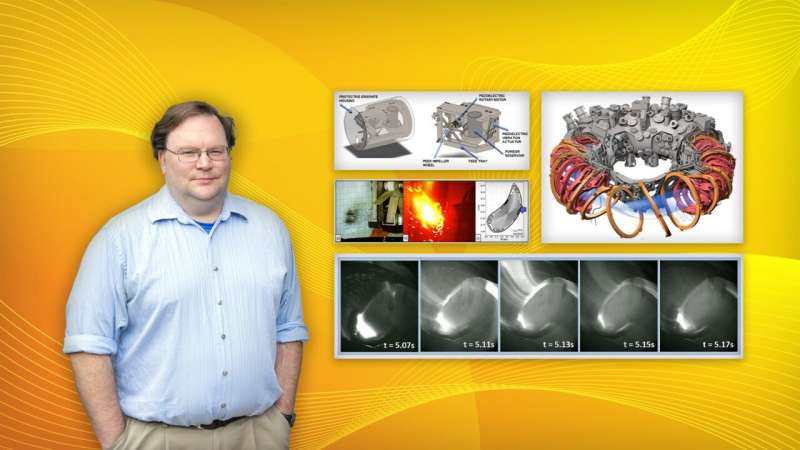Shaping up nicely: Adjusting the plasma edge can improve the performance of a star on Earth

While trying out a new device that injects powder to clean up the walls of the world's largest stellarator, a twisty fusion device known as Wendelstein 7-X (W7-X) in Greifswald, Germany, scientists were pleased to find that the bits of atoms confined by magnetic fields within the device got temporarily hotter after each injection. Researchers led by scientists at the U.S. Department of Energy's (DOE) Princeton Plasma Physics Laboratory (PPPL) in collaboration with the Max Planck Institute for Plasma Physics (IPP) in Germany found that pulsed injections of boron carbide, an ingredient in sandpaper, increased the density and temperature of the ultrahot atom fragments, or plasma, leading to better fusion performance.
Fusion, the power that drives the sun and stars, combines light elements in the form of plasma—the hot, charged state of matter composed of free electrons and atomic nuclei, or ions—that makes up 99 percent of the visible universe. The reactions, which scientists around the world are seeking to reproduce on Earth to generate electricity, produce massive amounts of energy.
Boron coatings are widely used to cover the interior of tokamaks, doughnut-shaped fusion devices that are operated around the world, along with stellarators, their twisting cousins. This coating prevents metals and other heavy elements from leaching from the walls into the plasma, making the fusion reactions less efficient. It also captures hydrogen that escapes from the main plasma, keeping it from returning into the plasma and cooling off the reactions.
These coatings wear away over time, however, and many techniques used today to re-apply them only work when the high-energy fusion plasma device is turned off. While this is not a problem for today's experiments, turning off future facilities will not be so easy because they will have to operate for weeks on end. "Finding a way to repair the coating on the walls while the fusion reaction is going on is an important part of our research," said PPPL physicist Robert Lunsford, lead author of a paper reporting the results in Physics of Plasmas.
At other fusion research facilities around the world, PPPL scientists have installed a three-foot-tall impurity powder dropper capable of distributing controlled amounts of powder directly onto the top of the plasma, like salt from a shaker. This technique was too difficult to install on W7-X in the available installation time, though it may be incorporated into the device in the future.
"Instead, we had to strip out everything we could to shrink one of the powder droppers to the size of a loaf of bread so it would fit on a mechanical arm that reaches inside the plasma," Lunsford said. "For a prototype, it worked very well."
What excited researchers was seeing the temperature go up after the injection. The Physics of Plasmas paper reported that the injected boron carbide appears to cool the edge of the plasma and increase the density gradient. "This means that the plasma edge gets denser faster as you move from the edge to the core," Lunsford said. "This in turn reduces turbulence, the complex swirls that flush heat from the plasma." Because of that reduced turbulence, the plasma retains more of its heat and makes the fusion reactions more efficient.
"These results were very exciting," said PPPL physicist Novimir Pablant, one of the paper's co-authors. "There are only a few ways to get ions hot, so any new tool helps a great deal. Now we hope to use this technique to have more control over the plasma's shape."
The researchers plan to conduct more experiments to confirm this finding. They also will work with W7-X scientists who have discovered other ways to change the plasma shape by techniques like launching hydrogen pellets at high speeds into the plasma core. These profile-shaping tools are an important step in advancing fusion research, the physicists say.
Collaborators on this research included scientists from Germany's Max Planck Institute for Plasma Physics and Jülich Research Centre, Hungary's Center for Energy Research, and Spain's Fusion National Laboratory.
More information: R. Lunsford et al, Characterization of injection and confinement improvement through impurity induced profile modifications on the Wendelstein 7-X stellarator, Physics of Plasmas (2021). DOI: 10.1063/5.0047274
Journal information: Physics of Plasmas
Provided by Princeton Plasma Physics Laboratory





















